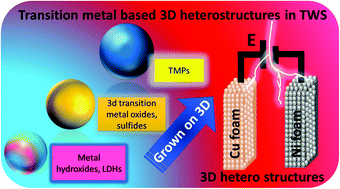Advancing the extended roles of 3D transition metal based heterostructures with copious active sites for electrocatalytic water splitting
Abstract
The replacement of noble metals with alternative electrocatalysts is highly demanded for water splitting. From the exploration of 3D -transition metal based heterostructures, engineering at the nano-level brought more enhancements in active sites with reduced overpotentials for both the oxygen evolution reaction (OER) and hydrogen evolution reaction (HER). However, recent developments in 3D transition metal based heterostructures like direct growth on external substrates (Ni foam, Cu foam) gave highly impressive activities and stabilities. Research needs to be focused on how the active sites can be enhanced further with 3D heterostructures of transition metals by studying them with various counterparts like hydroxides, layered double hydroxides and phosphides for empowering both OER and HER applications. This perspective covers the way to enlarge the utilization of 3D heterostructures successfully in terms of reduced overpotentials, highly exposed active sites, increased electrical conductivity, porosity and high-rate activity. From the various approaches of growth of transition metal based 3D heterostructures, it is easy to fine tune the active sites to have a viable production of hydrogen with less applied energy input. Overall, this perspective outlines a direction to increase the number of active sites on 3D transition metal based heterostructures by growing on 3D foams for enhanced water splitting applications.

- This article is part of the themed collection: 2021 Frontier and Perspective articles


 Please wait while we load your content...
Please wait while we load your content...